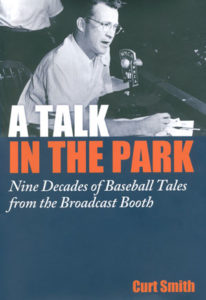A Talk in the Park
 Since the debut of radio and later television, the baseball announcer has been a reporter, entertainer, and welcome visitor, above all. In A Talk in the Park: Nine Decades Of Baseball Tales from the Broadcast Booth (Potomac Press, 2011, 308 pages), many of the pastime’s most popular and famous announcers—the Voices—tell their favorite stories. Some are from the public record or author Curt Smith’s longtime research. The vast majority were told for the first time by Voices specifically for this book. The result is riveting oral history.
Since the debut of radio and later television, the baseball announcer has been a reporter, entertainer, and welcome visitor, above all. In A Talk in the Park: Nine Decades Of Baseball Tales from the Broadcast Booth (Potomac Press, 2011, 308 pages), many of the pastime’s most popular and famous announcers—the Voices—tell their favorite stories. Some are from the public record or author Curt Smith’s longtime research. The vast majority were told for the first time by Voices specifically for this book. The result is riveting oral history.
Endorsed by the Baseball Hall of Fame and the National Radio Hall of Fame, this work boasts the largest total of active and retired broadcasters featured in any sports book: 116. Its radio and TV tales include every major-league team and such networks as ESPN, Fox, TBS, and MLB. The announcers discuss players, ballparks, managers, umpires, executives, teams, broadcast humor—and one another, including the late and beloved Ernie Harwell, to whom the book is dedicated.
Here are Bob Wolff airing the longest-ever wild pitch, Howie Rose using the 1969 Mets to pass a high school exam, and Charley Steiner telling why George Steinbrenner “hired” Jason Giambi. Denny Matthews recalls George Scott’s faux uniform number 6-4-3. Ken Harrelson defends his one-handed catch: “With bad hands like mine, one hand was better than two.” Pat Hughes remembers Harry Caray broadcasting with a tea bag dangling from his ear. Voices hail Lou Piniella: dressed, undressed, volatile, and lovable.
Columnist Christine Brennan says: “No one knows baseball broadcasters as well as [Curt Smith] does.” In particular, A Talk in the Park addresses trends of the past several decades—the rise of Hispanic and other minority announcers, substance abuse, interleague play, ex-jocks’ warp-speed climb, whiz-bang technology, and the evolution of big-league coverage, from radio to network TV to cable. Told by baseball’s leading broadcast authority, featuring Voices heard and seen by millions, A Talk in the Park relates what baseball was, is, and is likely to become.
